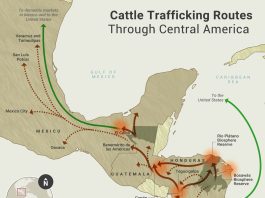Since most of our readers spend a lot of time in tick habitat, we’re sharing these symptoms of the most common tick-borne illnesses. If you do get infected, getting treatment early is important, so we hope this helps keep you all safe. (And if you want to know how to prevent tick bites, check out this article.)
Lyme Disease
The first case of this disease was reported in Old Lyme, Connecticut in 1975. Today, about 300,000 people are diagnosed with lyme disease every year in the United States with the Northeast and Great Lakes regions accounting for the vast majority of these cases. Over the last ten to 15 years, deer ticks have also moved into Canada, thanks to a changing climate creating new habitats further north, and they’ve brought with them a variety of tick-borne diseases including Lyme. In fact, reported cases have increased from 144 in 2009 to 987 in 2016. (Our Canadian readers might be interested in this article about difficulties they might have in getting diagnosed and treated.)

 Lyme Disease is caused by the bacteria Borrelia burgdorferi sensu lato. B. burgdorferi, transmitted to humans by a bite from an infected blacklegged or deer tick which got the infection from infected deer or mice.Most people never even know they were bitten, so when they start experiencing symptoms, they may not associate them with Lyme disease. Not all people get the bulls-eye rash that indicates the disease is beginning to spread through the blood stream. Others have a rash that is solid red, while people with dark complexions may have a rash that resembles a bruise. Others may get no rash at all but suffer from other flu-like symptoms. If you’ve been outdoors in tick habitat, pay attention, and consider a doctor’s visit for chills, fever, enlarged lymph nodes, sore throat, vision changes, fatigue, muscle aches and headaches.
Lyme Disease is caused by the bacteria Borrelia burgdorferi sensu lato. B. burgdorferi, transmitted to humans by a bite from an infected blacklegged or deer tick which got the infection from infected deer or mice.Most people never even know they were bitten, so when they start experiencing symptoms, they may not associate them with Lyme disease. Not all people get the bulls-eye rash that indicates the disease is beginning to spread through the blood stream. Others have a rash that is solid red, while people with dark complexions may have a rash that resembles a bruise. Others may get no rash at all but suffer from other flu-like symptoms. If you’ve been outdoors in tick habitat, pay attention, and consider a doctor’s visit for chills, fever, enlarged lymph nodes, sore throat, vision changes, fatigue, muscle aches and headaches.
According to LymeDisease.org, “Untreated or undertreated Lyme can cause some people to develop severe symptoms that are hard to resolve. This condition may be referred to as post-treatment Lyme disease (PTLD) or chronic Lyme disease (CLD).” So be sure to take your symptoms seriously to prevent further harm. If you’d like, you can check your symptoms here.
The only known cure for Lyme disease is a long course of antibiotics. There is no evidence that naturopathic treatments do anything to help Lyme disease and they can be quite expensive.
Rocky Mountain Spotted Fever
This disease gets its name from the region where it was first discovered and is carried by the wood tick, and in the east, the dog tick. It has been reported throughout most the U.S., but five states (North Carolina, Oklahoma, Arkansas, Tennessee and Missouri account for 60% of cases. It is also increasingly common in certain parts of Arizona.

 The first signs that you might be infected include fever, headache, rash, nausea, vomiting, stomach pain, muscle pain, and lack of appetite. Two to four days in, you might also develop a spotted rash. The CDC says, “The look of the rash can vary widely over the course of illness. Some rashes can look like red splotches and some look like pinpoint dots. While almost all patients with RMSF will develop a rash, it often does not appear early in illness, which can make RMSF difficult to diagnose.” RMSF can be fatal, so if you are experiencing any of the symptoms after you’ve been in the woods, or know you were bitten by a tick, be sure to head to the doctor. RMSF is treated with an antibiotic and it does not result in chronic health problems unless treatment is delayed.
The first signs that you might be infected include fever, headache, rash, nausea, vomiting, stomach pain, muscle pain, and lack of appetite. Two to four days in, you might also develop a spotted rash. The CDC says, “The look of the rash can vary widely over the course of illness. Some rashes can look like red splotches and some look like pinpoint dots. While almost all patients with RMSF will develop a rash, it often does not appear early in illness, which can make RMSF difficult to diagnose.” RMSF can be fatal, so if you are experiencing any of the symptoms after you’ve been in the woods, or know you were bitten by a tick, be sure to head to the doctor. RMSF is treated with an antibiotic and it does not result in chronic health problems unless treatment is delayed.
If you have more information on how to be safe from ticks, do share it with your On Pasture Community!





During my college days (Eastern Oregon State, elevation 3,000′ and up), one of my professors had a daughter that was (eventually) diagnosed with tick paralysis. It seems that if a tick burrows into the soft tissue near the neck/head, (un-detected), it can cause bizarre neurological symptoms. A sharp emergency room doc spotted the trouble and she fully recovered. Pretty scary.
This episode made me more watchful. Tick inspection became routine.
Comments are closed.